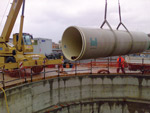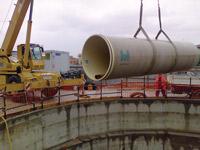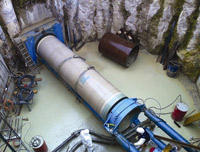
Case Study: Rome Microtunnels Bypass in Ancient System

For this trenchless technology solution, HOBAS 54-inch pipe, seen here being lowered into the jacking pit in Rome, offered installation advantages.
Problem: More than 25 centuries after the Cloaca Maxima was built, engineers are continuing to upgrade the sewer system while minimizing disruptions to a busy quarter of Rome, Italy.
The city’s main drain system, constructed late in the sixth century B.C., carried water from the baths, latrines, and the local marshes and discharged it directly into the Tiber River. The collection system had large openings which were enclosed in the third century B.C. Part of the modern current sewer network is made up of these ancient underground structures.
Recently, the municipal engineers designed a 54-inch diameter sewer bypass in Farnesina. The 1,000 foot line connects two existing 138-inch diameter concrete sewer collectors.
Solution: Farnesina, which sits on the right bank of the Tiber River, is the headquarters of the Italian Foreign Ministry, home to the Milvio Bridge, and the site of two sports facilities: the Olympic stadium and the Foro Italico. Two major roadways converge in the area, the Cassia and the Flaminia. For all these reasons, the engineers decided to use a trenchless solution. Microtunneling also kept the construction site comparably small.
SAFAB Spa. an Italian contractor specializing in hydraulic applications, was awarded the job and worked in close cooperation with La Falce Spa., a company with 50 years of experience and no-dig know-how.
The Work: The tunnel was prepared with a slurry pipe and a tunneling boring machine featuring a laser guidance control systems. Driving through different layers of soil ranging from clay to sand and gravel, a daily advance of 20 to 50 feet could be achieved.

Centrifugally cast, fiberglass-reinforced, polymer mortar pipes were used to upgrade the sewer collection system in Farnesina, a busy quarter in Rome, Italy.
The line consists of two straight runs (400 and 600 feet) that are connected with a 60-degree manhole that will be used for future access and inspection. The project’s main jacking station was erected at this intersection point.
The circular jacking shaft was designed with a 30-foot diameter and enabled drives in the two required directions from one single pit. Two thrust shields were built to keep the relatively light machine in position and it was simply rotated in place to the right position.
The first stretch of 400 feet was excavated with the thrust from the main station, in contrast to the longest stretch of 600 feet that had to be driven with an intermediate jacking station.
The 54-inch nominal diameter centrifugally cast, fiberglass-reinforced, polymer mortar jacking pipe had an external diameter of 59 inches and weighed 275 pounds per foot. The pipes on this project had an allowable thrust force up to 390 U.S. tons. The product’s smooth outer surface made it possible to reduce the amount of slurry needed. Additionally, the comparably small wall thickness reduced the amount of excavation material while maintaining flow capacity. In fact, it limited the use of bentonite-based lubricant to the final sections of both drives. The standard 20-foot pipe length and the light weight of HOBAS products proved to be advantageous, reducing installation time and cost.